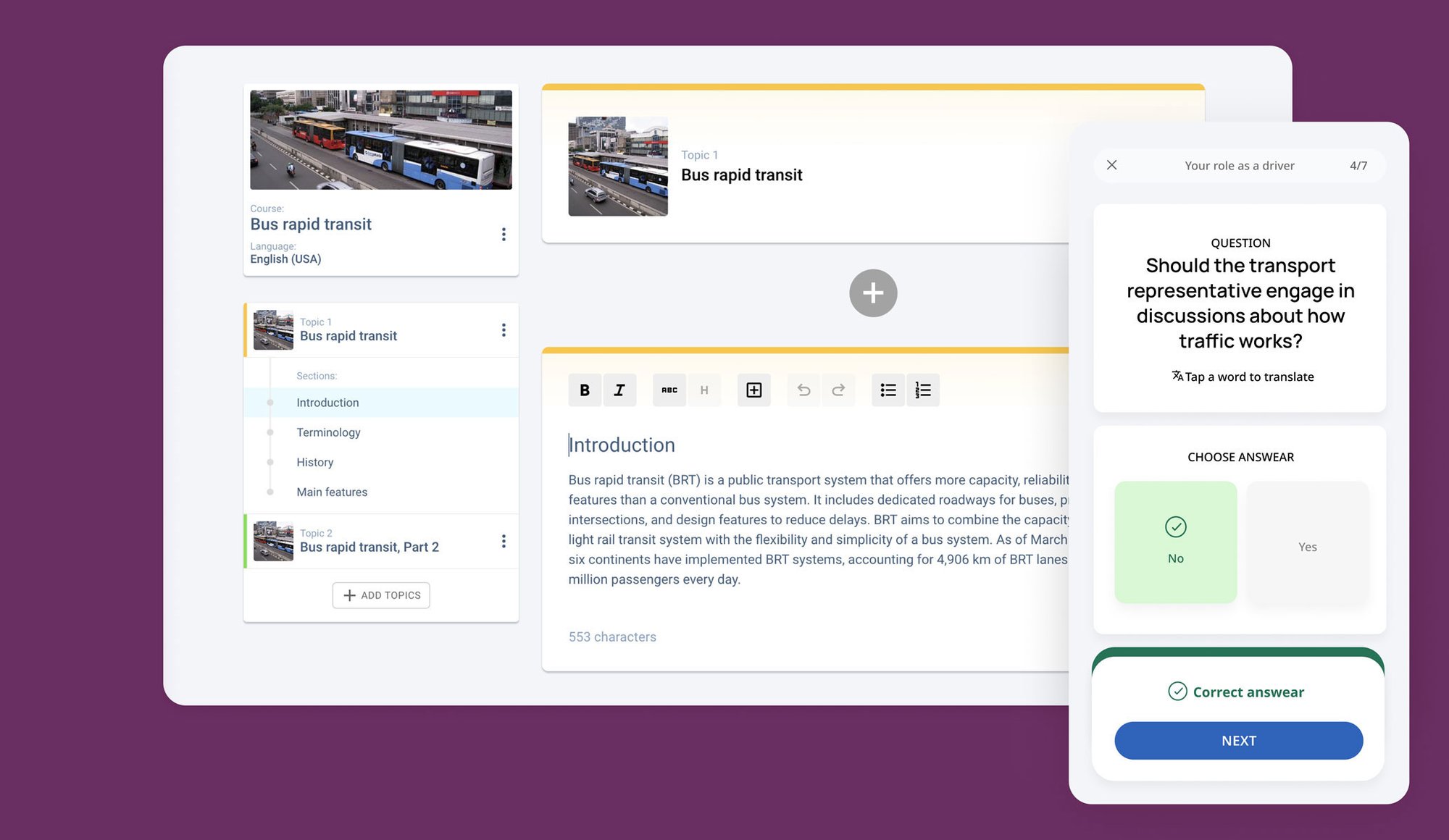Staff training and development plan template: Designing your employee training program
Once you’ve decided on an employee training program to create, it’s time to start bringing it to life with the help of our staff training and development plan template.
Understanding organisational needs and business goals
Developing a comprehensive employee development plan begins with a deep understanding of the organisation's needs and strategic goals. This foundational step ensures that the training programs are aligned with business goals and are designed to address the specific areas that drive performance and competitive advantage.
An organisational assessment can identify current capabilities, performance levels and how these align with the strategic objectives. Utilising tools like SWOT analysis can provide valuable insights into the organisation's strengths, weaknesses, opportunities, and threats, offering a structured way to evaluate internal and external factors impacting performance. Then, engage with various stakeholders across departments to gather diverse perspectives on the organisation’s capabilities and areas for improvement.
Some questions to consider:
- What are our long-term business goals?
- Where do we currently stand with achieving these goals?
Answering these questions will help pinpoint the specific training needs that align with strategic objectives.
Additionally, benchmarking against industry standards or competitors is essential to understand where the organisation stands in the competitive landscape and identify areas for improvement.
Use a benchmarking checklist to systematically compare your organisation’s practices and performance metrics against those of industry leaders or direct competitors. Then, implement a competitor analysis template to gather detailed insights on how competitors approach training and development, identifying gaps in your own programs or opportunities for differentiation. This analysis will highlight areas where the organisation can improve or capitalise on unique strengths, informing the development of targeted training programs that address specific competencies or knowledge gaps.
Identifying skill gaps
Creating a successful employee training program hinges on identifying the skills gaps within your team or organisation and aligning training initiatives with career progression opportunities. This strategic alignment ensures that your workforce is competent in their current roles and prepared for future growth and challenges.
Be sure to conduct a thorough skill gap analysis. Utilising a skill gap analysis worksheet, list the essential skills required for each role within the organisation. Then, compare the current competencies of your employees with the skills necessary for their roles to identify where gaps exist.
This comparison will highlight the specific areas where training is needed to elevate the team's performance and meet organisational objectives. A training needs analysis pinpoints the skills your employees need to excel, be it digital competencies for remote work or specialised skills for technical training.
Equally important is planning career pathways within the organisation, which guides employees toward future roles and responsibilities. A career pathway template helps outline the potential progression routes for each position, detailing the skills and training required at each stage.
Be sure to define clear career paths for employees, identifying the necessary training and development programs that support their growth within the company. This process aids in employee retention by providing a clear vision of their future within the organisation.
Setting clear objectives and milestones
Crafting an effective staff development program begins with establishing clear, strategic objectives and carefully planning milestones to chart progress. This process ensures training aligns with the organisation's goals and addresses specific needs, leading to meaningful and measurable outcomes.
The foundation of a successful training initiative is the formulation of SMART objectives.
These objectives should be:
- Specific: Clearly define what you aim to achieve with the training program, identifying the skill gaps and career pathways targeted.
- Measurable: Establish criteria for measuring progress towards each objective, enabling you to track effectiveness and make adjustments as necessary.
- Achievable: Ensure the goals are realistic and attainable, considering the resources available and the current capabilities of employees.
- Relevant: Align the objectives with both individual career aspirations and organisational strategic goals, ensuring the training is meaningful and beneficial.
- Time-bound: Set deadlines for achieving each objective, creating a sense of urgency and focus.
Use an objective setting worksheet to methodically set out these training objectives, directly addressing the identified skill gaps and career development opportunities within your organisation. With objectives in place, the next step is to break these down into actionable milestones using a milestone planning chart.
This involves:
- Identifying key stages in the development program, from initial assessment to implementation and evaluation of training.
- Assigning responsible parties for each milestone, ensuring accountability and clarity in roles.
- Setting realistic deadlines for each phase, allowing for a structured progression through the training program.
Milestone planning facilitates a smoother execution of the training program and provides regular checkpoints for evaluating progress and adjusting the strategy as needed. It transforms broad objectives into tangible, achievable steps, guiding both trainers and trainees towards successful outcomes.
Program implementation plan
Implementing a staff training and development program is a critical phase that demands careful planning and resource management to ensure its success. This stage involves the strategic allocation of resources and the execution of a comprehensive communication plan.
Resource allocation
Allocating the necessary resources effectively is pivotal for the smooth execution of the training program.
Resource allocation includes considering:
- Budget: Establish a clear budget using a budget template to cover all costs associated with the program, including instructors, materials, technology, and any other expenses.
- Instructors: If you require instructors, select qualified experts in their respective fields to deliver high-quality training.
- Materials: Preparing or procuring all necessary training content, ensuring it's up-to-date and relevant.
- Technology: Leverage eLearning platforms like Lingio to easily create staff development courses and programs, enhancing accessibility and engagement for participants.
- A resource allocation spreadsheet: Consider using this tool to track the distribution of resources, ensuring that every aspect of the program is adequately supported.
Communication employee development plan
Effectively communicating the training program to all stakeholders is essential for its acceptance and success.
This involves:
- Scheduling: Outline the training schedule, including dates, times, and locations, to ensure participants can plan accordingly.
- Formats: Determine the most effective formats (e.g., online learning apps, email, meetings, intranet postings) for reaching your audience.
- Communication plan template: Use this tool to organise and document your communication strategy, ensuring clarity and consistency in messaging.
Monitoring and evaluation
An integral component of a successful staff training and development program lies in its continuous monitoring and evaluation. This phase ensures that the program meets its intended objectives and provides opportunities for improvement and alignment with organisational goals.
A progress tracking dashboard enables real-time observation of individual and group advancements, offering insights into training effectiveness. LMS tools like Lingio can provide analytics on completion rates and engagement levels. This data is invaluable for proving your training initiatives' return on investment (ROI), showcasing the tangible benefits of employee skill enhancement and organisational performance.
Metrics such as engagement rates, completion percentages, and relevance scores are key indicators of how well the training resonates with employees and contributes to closing the identified skill gaps.
Collecting feedback from participants and stakeholders is a vital step in the evaluation process. A staff training training and development questionnaire facilitates this, allowing for gathering insights and suggestions directly from those involved. This feedback provides a foundation for making necessary adjustments to the program, ensuring it remains responsive to the needs of the participants and the organisation.
A program adjustment checklist can guide these revisions, ensuring that changes are methodically implemented and aligned with the program's objectives.
Best practices for employee training and development
Following some best practices in employee development can enhance individual performance and drive organisational growth.
Here are three key practices to ensure the effectiveness of employee training programs:
- Tailoring employee development plans to specific needs: Customisation is at the heart of effective staff development. Recognising that employees have unique skills, career development goals, and learning preferences is crucial. Tailored employee development programs offer more than just generalised knowledge. They provide specific insights and skills that align with individual career development paths and organisational goals.
- Creating a culture of continuous learning: A work culture that values and encourages ongoing education and skill acquisition sets the foundation for continuous organisational improvement. Encouraging employees to engage in lifelong learning and providing opportunities for such engagement are essential. This can be achieved through regular training sessions, workshops, and seminars that address emerging trends and technologies. Moreover, creating a supportive environment where learning is recognised and rewarded motivates employees to pursue further development, leading to a more adaptable and forward-thinking workforce.
- Leveraging technology and digital tools: Learning management systems (LMS) and all-in-one solutions such as Lingio offer sophisticated tools for designing, distributing, and monitoring employee training programs. Platforms like Lingio can create custom, gamified training courses using AI to teach employees efficiently and effectively. By utilising such technologies, organisations can deliver training more effectively, track progress and measure the impact of training on business objectives. Furthermore, digital tools facilitate access to training materials anytime, anywhere, enhancing learning flexibility and engagement.







